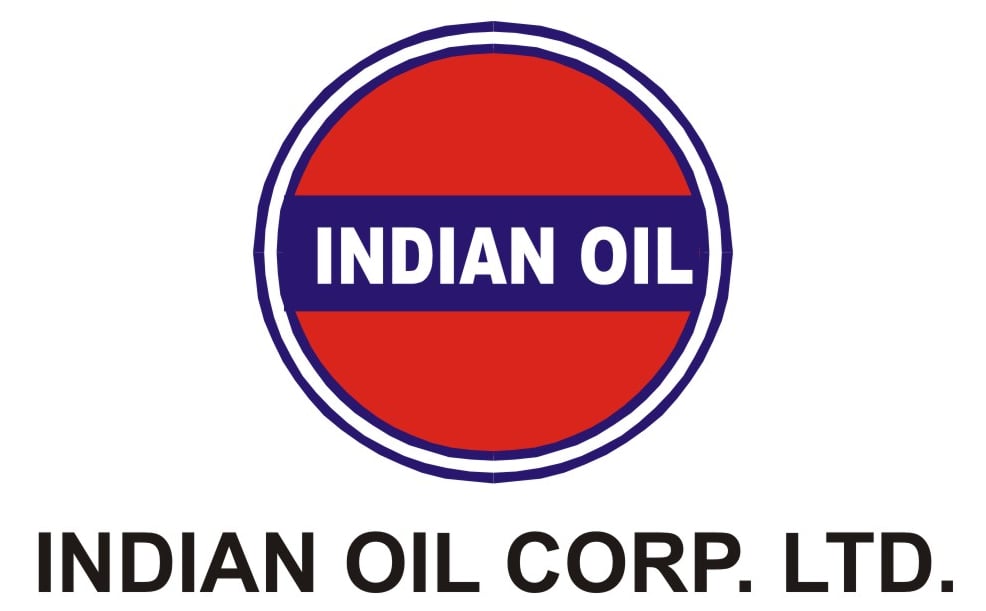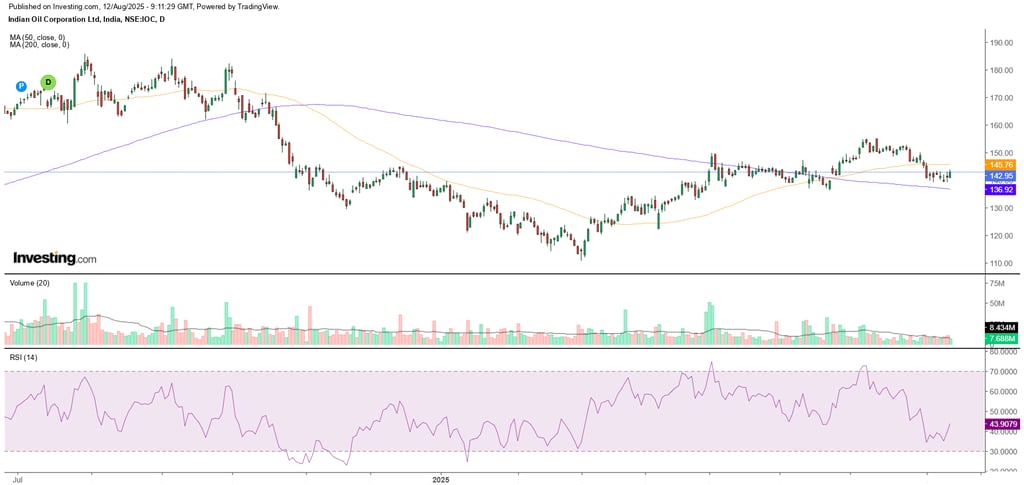Indian Oil Stock Analysis
Fundamental and Technical Analysis of Indian Oil Corporation
STOCK ANALYSIS
8/12/20257 min read


About Company
Indian Oil Corporation Limited (IOCL) is a government-owned company and India's largest energy provider, known for supplying fuel like petrol, diesel, LPG, and natural gas to millions of people across the country. It was established in 1959 and is managed by the Government of India. IOCL plays a key role in refining crude oil, transporting it through long pipelines, and delivering petroleum products to homes, vehicles, industries, and even airplanes. The company also produces petrochemicals and lubricants, and it has started working on alternative energy sources such as electric vehicle charging stations, biofuels, and solar energy. Indian Oil’s operations are spread across India and it even has branches in other countries like Sri Lanka and Mauritius.
Business Segments
It operates through multiple business segments covering the entire hydrocarbon value chain. Its main segments include Refining, where it processes crude oil in 11 refineries across India; Pipelines, managing a vast network for transporting crude oil and petroleum products; Marketing, distributing fuel through a large network of retail outlets and LPG distributors; Petrochemicals, producing chemicals for various industries; Natural Gas, including import, marketing, and city gas distribution; Exploration & Production (E&P), involving upstream activities both domestically and internationally; and Explosives and Cryogenics, offering industrial explosives and related services. Additionally, IOCL is expanding into Alternative Energy sources such as renewables, biofuels, green hydrogen, and sustainable aviation fuel. This integrated model helps IOCL maintain a significant presence across India's energy landscape while also growing internationally.
Company's Facility
It has an extensive network of facilities across India, primarily comprising nine strategically located refineries. These refineries are located in Digboi, Guwahati, Barauni, Koyali (Gujarat), Haldia, Mathura, Panipat, Bongaigaon, and Paradip. Together, they form a critical part of India's fuel supply chain, with varying capacities to process crude oil into various petroleum products. Besides refineries, IOCL operates a vast pipeline network, divided regionally into the northern, western, southern, eastern, and southeastern parts of India, to transport crude oil and refined products securely and efficiently. IOCL also maintains several key regional offices and marketing hubs in major cities such as Mumbai, New Delhi, Chennai, Kolkata, and others to manage distribution and sales operations. Additionally, the company operates research and development facilities to innovate and promote clean energy initiatives. This integrated infrastructure enables IOCL to maintain its position as India's largest energy provider across the entire hydrocarbon value chain.
Production Capacity
The company has a significant refining production capacity of about 80.75 million metric tonnes per annum (MMTPA) through its 11 major refineries across India, including the subsidiary Chennai Petroleum Corporation Limited which contributes about 10.5 MMTPA. IOCL accounts for approximately 31% of India’s total refining capacity. The company is actively expanding its refining capacity aiming to reach 107 MMTPA by 2025 with ongoing upgrades at refineries such as Guwahati, Barauni, Gujarat (Koyali), Panipat, Digboi, and Cauvery Basin. Major expansion projects include increasing Panipat’s capacity from 15 MMTPA to 25 MMTPA, Gujarat refinery from 13.7 MMTPA to 18 MMTPA, and Barauni from 6 MMTPA to 9 MMTPA, with planned completion by the end of 2025. These expansions are part of broader strategic investments to enhance IOCL’s role in meeting India’s growing energy demands while also integrating petrochemical production.
Future Plans
Indian Oil Corporation Limited (IOCL) has ambitious future plans focusing on growth, diversification, and sustainability. The company aims to expand its refining capacity significantly by completing ongoing projects to increase refinery capacities at Panipat (from 15 to 25 MMTPA), Gujarat (13.7 to 18 MMTPA), and Barauni (6 to 9 MMTPA) by the end of 2025. Beyond refining, IOCL plans to triple its natural gas sales and boost its renewable energy capacity to 31 GW by 2030, mainly through solar and wind projects. It is investing in clean energy technologies including green hydrogen, biofuels, and electric vehicle infrastructure like battery swapping stations.
IOCL is also diversifying into new sectors such as data centers, nuclear power generation, battery manufacturing, and critical mineral mining as part of its long-term vision to reach $1 trillion in revenue and achieve net-zero emissions by 2047. To support green energy growth, IOCL has established subsidiaries and joint ventures focused on renewable projects and advanced battery technologies. The company is strengthening its upstream oil and gas exploration and aims to increase petrochemical capacity more than threefold by 2028. IOCL's future strategy integrates expanding core oil and gas operations with aggressive clean energy initiatives to balance profitability and sustainability in India's evolving energy landscape.
Financial Prospects of The Company
Market Valuation & Stock Price
The market valuation of the company is 2,01,934 crores, and the stock price is 143
Price-to-Earnings Ratio (P/E Ratio)
The price-to-earnings ratio of the company is 16.7
Book Value (PB Ratio)
The book value of the company is 132
Price to Book Value (PE X PB)
The price-to-book value of the company is 17.8
Earnings Per Share (EPS)
The earnings per share are 9.63
Return Ratios
The Return on Capital Employed (ROCE) is 7.37% and Return on Equity (ROE) is 6.56%
Dividend Yield
The annual dividend of the company is 2.08%
Sales & Profit in The Last 5 Years
In FY 2020-21, sales were 3,63,950 crores and profits were 21,762 crores. In FY 2021-22, sales were 5,89,321 crores and profits were 25,727 crores. In FY 2022-23, sales were 8,41,756 crores and profits were 11,706 crores. In FY 2023-24, sales were 7,76,352 crores and profits were 43,161 crores. In FY 2024-25, sales were 7,58,106 crores and profits were 13,789 crores.
Sales & Profit Growth in The last 5 Years
In the last 5 years, sales growth was 9.40% and profit growth was 22.6%. In the last 3 years, sales growth was 8.76% and profit growth was -21.5%. In the last 1 year, sales growth was -2.35% and profit growth was -70.7%
Investors
Shareholding Pattern
The Promoters hold 51.50%, FII hold 7.48%, DIIs hold 10.29%, Government hold 19.57% and the public hold 11.15%
Company News
Indian Oil Corporation Limited (IOCL) has recently announced a final dividend of ₹3 per equity share for the financial year ended March 31, 2025, subject to shareholder approval at the upcoming Annual General Meeting. The record date for this dividend is August 8, 2025. This payout reflects IOCL's commitment to providing strong shareholder returns despite challenging market conditions.
For FY 2024-25, IOC faced some pressure on profits due to weaker refining and marketing margins but still achieved a significant milestone by crossing 100 million metric tons in both sales and pipeline throughput for the first time. The company reported revenue of ₹7,58,106 crore and a net profit of ₹13,789 crore for the year.
IOC is actively expanding its natural gas presence and clean energy initiatives, including supplying LNG to a new gas-based power plant in the Andaman & Nicobar Islands expected to be operational by 2027–28. The company is also supporting infrastructure development there to reduce reliance on diesel and promote clean energy sources.
On the stock market, IOC's share price has been showing positive movement, trading around ₹142-143 per share as of August 2025, with a market capitalization of ₹2.01 lakh crore. The company remains focused on balancing profitability with sustainability amid global oil price fluctuations and growing competition from renewable energy sources.
Additionally, Indian Oil Corporation has confirmed that its premium fuel XP95 now contains a 20 percent ethanol blend as part of its commitment to cleaner fuels.
Technical Analysis
Company Chart
Moving Average (MA)
The stock is trading under the 50-MA, which indicates that the stock is in a bearish trend.
The stock is trading above the 200-MA, which indicates that the stock is in a bullish trend.
Chart Pattern
The chart pattern of the stock shows that the stock has faced significant correction in the last 1 year, but now it is moving upward. It may give a breakout if the market condition gets better.
Relative Strength Index (RSI)
Currently, the RSI of the stock is 43, which indicates that the stock is neither in the oversold zone nor in the overbought zone.


Strengths & Weaknesses
Strengths
Extensive network with over 60,000 customer touchpoints and a strong brand presence in India, including well-known products like Indane LPG and Servo lubricants.
Ownership and operation of one of the world's longest pipeline networks (over 19,300 km), ensuring efficient transport of crude oil, petroleum products, and gas.
Large refining capacity with 11 major refineries and significant market share in petroleum products, pipeline, and refining sectors in India.
Strong distribution network with widespread retail outlets and marketing hubs across India.
Advanced research and development facilities supporting innovation in refining, lubricants, and pipeline technologies.
Effective go-to-market strategies and customer loyalty programs like the XTRAPOWER Fleet Card Program.
Robust infrastructure backed by government ownership, providing stability and resources for operations.
Weaknesses
Strong competition from major domestic players like Reliance Industries, Bharat Petroleum, and ONGC, which challenge IOCL’s market share and innovation pace.
Government control restricts pricing flexibility and profitability due to policies like fuel price controls and subsidy dependencies.
Overreliance on fossil fuels, which poses a risk amid the global shift towards renewable energy and cleaner technologies.
Slow diversification into new clean energy sources compared to the fast-changing energy landscape.
Aging infrastructure in refineries and pipelines requiring significant modernization and capital investment.
High operational and debt costs, with rising liabilities potentially limiting strategic and financial flexibility.
Exposure to environmental concerns and regulatory pressures related to pollution and carbon emissions.
Vulnerability to global oil price fluctuations, geopolitical risks, and operational hazards like spills and accidents.
